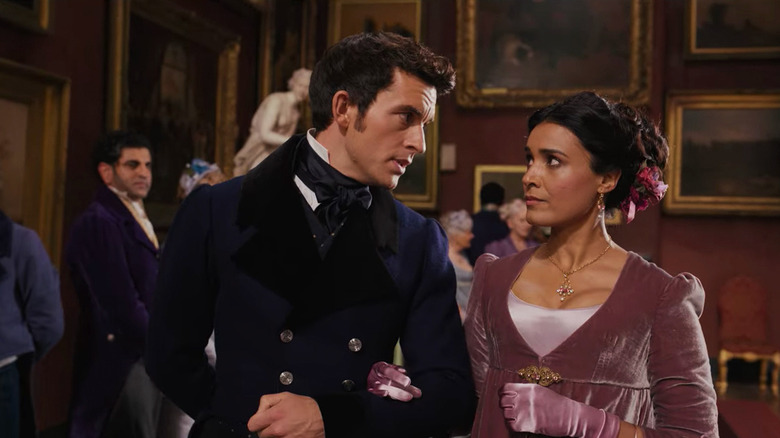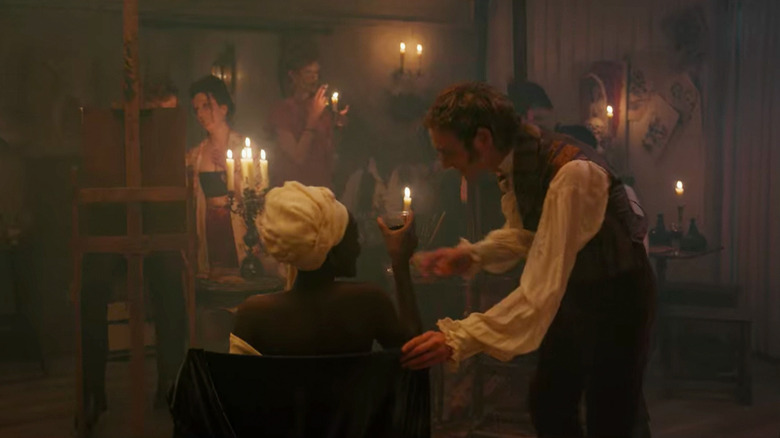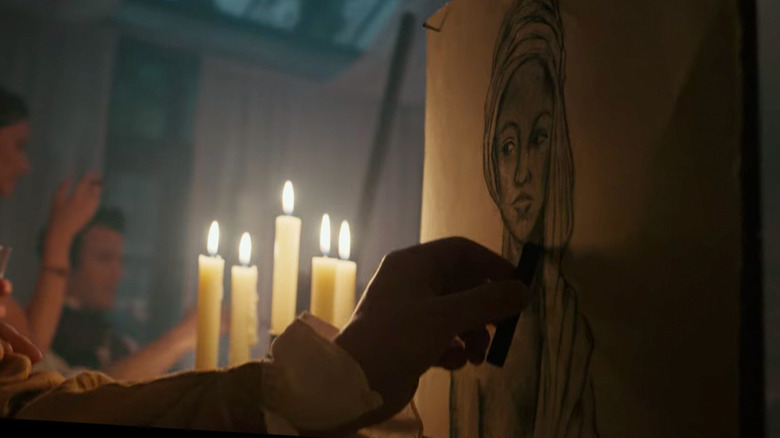The Famous Painting That Bridgerton Brought To Life
This post contains minor spoilers for Bridgerton season 2.
Whether you love "Bridgerton" to death or feel yourself cringing at the "Gossip Girl"/Regency-period mashup, it's hard to deny its cultural impact. "Bridgerton" is a bit more than a racy remix of the genre that made Jane Austen such a household name; it's also taken major strides in normalizing diverse casting in period dramas. There's still a long way to go, even for the Shondaland series itself, but if there's one thing that its color-conscious casting has brought to the fore, its that people of color did exist in 19th century Europe, full-stop. They certainly weren't dukes, duchesses, or landed gentry (not all of them, anyway), but they were there. And it's gratifying to see characters of color join in on the sweeping fantasy.
The Netflix series is unpacking this concept a bit more in its second season, as certain members of the Bridgerton clan explore the world beyond their privileged 'ton. Eloise (Claudia Jessie) grows wise to the plight of lower class women, and realizes that her understanding of feminism has been pretty one-sided. Meanwhile, Benedict (Luke Thompson) is off to art school, to hone the skills (and the bohemian inclinations) he began to nurture in season one. He falls in with a group of art students and whiles away his days sketching out nude models — he even does a bit of nude modeling himself (Scandalous!).
Though very few of Benedict's new friends are people of color, "Bridgerton" does feature one Black character at the Academy: a woman who actually existed, and even modeled for a famous 19th century painting.
The painting that inspired the series
Episode seven, "Harmony," sees Anthony descend from his moody bachelor pad to visit Benedict at the Academy. The younger Bridgerton is engaged at a salon-style party; he and his artist friends are sketching a model who happens to be a Black woman. However, she's not just any Black woman. She's dressed in the exact same style as the model in "Portrait de Madeleine," a famous work of art created by French painter Marie-Guillemine Benoist in real life.
Sadly, not a lot is known about the subject of the painting, but historians have a pretty thorough record of the artist. Benoist was an aristocrat, which, like Benedict, gave her the freedom to pursue a career in art. She spent eight years painting during one of France's most turbulent eras, most of which was generally well-received — "Portrait de Madeleine" has been hanging in the Louvre since 1818. Many art historians view "Portrait de Madeleine" as Benoist's subtle condemnation of slavery in the French colonies and of the treatment of women in mainland France. It was most likely completed in 1800, right in the midst of the Haitian Revolution (after which Haiti gained independence from France) and a few years before Napoleon enacted the Napoleonic Code, which drastically reduced the rights of French female citizens.
The history of Black representation in portraiture — especially during this period — is disappointing at best. Many former slaves from the Americas, while technically free in Europe, were used as accessories for the portraits of wealthy white patrons. Only a handful of works from this era subvert that expectation, and "Portrait de Madeleine" is one of them. The fact that Madeleine is depicted alone, not as a servant, and swathed in high-quality fabrics removes her from the typical colonialist gaze. However, none of this excuses Benoist from any colonialist allegations herself.
How Bridgerton subverts Benoist's work
Just as Benoist's portrait was, to some, a statement against Eurocentric (and patriarchal) oppression, Madeleine's cameo in "Bridgerton" feels like a statement all its own, one that highlights a person of color from the era while also slightly critiquing her claim to fame. It's likely that Benoist's model was a freed slave who, upon arriving in France, became a servant. It's much better than the alternative, but Madeleine still lacked any autonomy, which means she was obliged to sit for Benoist's portrait whether she wanted to or not, and had no say in the manner Benoist depicted her.
Madeleine's appearance in "Bridgerton," on the other hand, reframes that narrative, however unconsciously. In the series, Madeleine is decidedly a free woman, making her choice to sit for a portrait completely and totally hers. There's also a chance that she's a student herself, like Benedict's current flame Tessa, who works as a model to fund her art school education. This is all, of course, hopeful speculation — Madeleine never gets the chance to actually speak, much less confirm any of my theories — but it's refreshing to see representation addressed with a bit more intention.
It also helps that this scene (and this episode) was directed by a Black woman, Cheryl Dunye. The "Watermelon Woman" director specializes in dissecting race, gender and sexuality in her work, and her influence can certainly be felt here. Though speaking roles — and meaningful arcs — are still in short supply for the characters of color on "Bridgerton," things are still progressing. Hopefully they build on this progress in the seasons to come.


